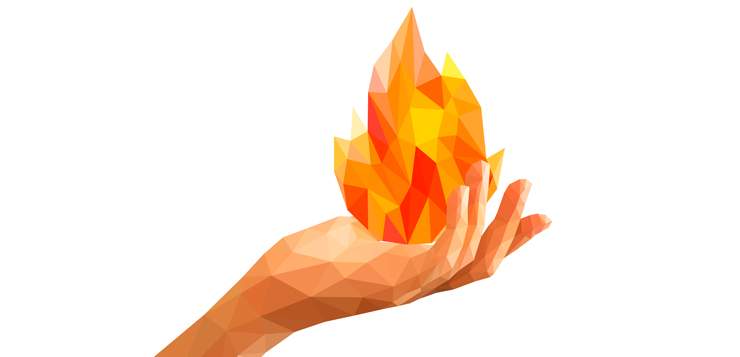Can you feel the heat?
Life feels a little more intense these days: at home, work, out in the world. When life begins to feel more intense than normal, it’s important to remember to slow down, turn toward these bigger feelings, and see the bigger picture. Take each day at a time.
Life is always in flux. Every thought, feeling, and moment is quickly changing into the next. In the moment, when something feels difficult, it seems like it will never pass. The practice is learning how to stay with and turn toward the difficulty.
The power of learning how to live a mindful life is to embrace this truth as much as you possibly can and live for the moment with some future planning that you hold loosely.
What I hear from most of my clients and students is that uncertainty is what creates the most difficulty. As much as we would like to know, to control, and to plan every little part of our lives so that it all works out in a way that creates more security and ease, we cannot. Life will always be impermanent and therefore always uncertain. We never really know what is coming next and sometimes the best and most courageous thing we can do is put one foot in front of the other and keep breathing through all of it. The power of learning how to live a mindful life is to embrace this truth as much as you possibly can and live for the moment with some future planning that you hold loosely.
The more we can meet any difficulty with presence, compassion, and kindness, the easier we can move through it. It requires that we learn to stay by turning toward the difficulty versus pushing away.
Meditation trains you to be resilient. The more you can learn to stay with all the highs and lows of your thoughts, emotions, and physical sensations, the more strength you can bring to each moment and experience.
For example, the other week, a good friend was going through a lot of difficulty and loss. After meeting with him recently, I was struck by how intense the feelings of sadness and loss were transmitted between us. I spent a few days afterward feeling off center, crying off and on, and feeling a bit agitated in my body. At first, I was taken aback by how intense these feelings were and noticed my mind trying to make sense of what was happening. The more I could turn toward my experience, and the physical sensations in my body, with compassion and understanding, I could feel the emotions passing and releasing.
Meditation trains you to be resilient. The more you can learn to stay with all the highs and lows of your thoughts, emotions, and physical sensations, the more strength you can bring to each moment and experience.
Neuroanatomist Jill Bolte Taylor shares in her research that most emotions don’t last longer than 90 seconds. I first heard about the lifecycle of emotions several years ago. I felt relieved to hear this 90-second timespan because it had mirrored some my experiences as a meditation practitioner for nearly 20 years. In the beginning of my practice, I had big waves of emotions that definitely lasted longer than 90 seconds. Why? I had never really sat with myself or allowed these feelings to be seen so there was a lot inside of me that wanted to come out. However, with time and practice, whatever feeling I was having passed through me more easily—as long as I brought my attention, understanding and compassionate observing to the table. In the case of grief, PTSD, and/or depression there may be more time needed to work with these feelings and I recommend that anyone with depression or mood disorders consult a mental health professional before beginning or altering any course of treatment.
I have also found, personally and professionally, that other somatic-based therapies can be complimentary to a meditation practice for approaching difficult emotions, including somatic release, acupuncture, yoga, and daily movement.
What Does Staying with Uncertainty Look Like?
We have a tendency to resist, reach for something pleasant, or deny the difficulty by putting our heads in the sand and this can ultimately create more suffering. This is a phrase I say to myself at any time I feel fear, anger, or confusion arising. It encourages me to stay and be here no matter what I am experiencing:
“I am here.”
“I am now.”
“All I need is within me.”
“All I need comes to me.”
Below is a meditation practice I have been using on myself and with clients that can support you to stay with what is difficult.
Guided Meditation for Difficult Emotions
Working with Difficult Emotions
- Come into a comfortable sitting position. Imagine something difficult that you are going through. It doesn’t have to be the most difficult, but something moderately difficult. We want to practice with moderation before we move into the most difficult. Now, recognize your desire to push away the difficulty, to reach toward something that would soothe the difficulty in the moment (reaching out to someone, chocolate, distracting with technology, etc.), or denying that this difficulty is actually happening.
- Now turn toward it. Breathe deeply in through your nose and out through your mouth a few times. Now invite into your awareness a large figure of compassion and strength who envelops you in a blanket of love, acceptance, and security. It can be a big cloud of compassion, a large grandmotherly figure, anything that feels loving and kind. Now, imagine this figure is holding you.
- Turn fully towards your difficulty. Face it, head on. There is no need to be scared. Feel this wise being enveloping you and speaking kindly to you: “It will be okay, you are okay, you are lovable, you are enough, you are not alone, and we will get through this together.” Let yourself offer and receive loving and kind statements as many times as you need until your mind and body can soothe and slow down.
- Each time, you notice yourself reaching for the old familiar way of turning away from discomfort, try gently turning toward it. The more you train the mind to acknowledge and name whatever difficulty is here, it won’t feel so challenging. In addition, your limbic system and specifically your amygdala will send a signal to your sympathetic nervous system that you can physiologically relax.
- When I do this meditation, I often hold stones that are comforting to me, such as rose quartz, while sitting on my meditation cushion. You can find the props or comforts that speak to you.
Read more
How Meditating Helps You with Difficult Emotions
Meditation is not all calm and peace. It opens up a space for you to see what’s going on in your mind, including the vivid and powerful movement of your emotions—up, down, and sideways. You can learn to fight with them less, and make friends with them more.
Read More
RAIN: A Mindfulness Practice for Welcoming Your Emotions
This four-step practice helps you recognize your emotions so you can respond, not react, to challenging situations.
Read More










